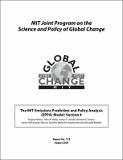| dc.description.abstract | The Emissions Prediction and Policy Analysis (EPPA) model is the part of the MIT Integrated Global Systems Model (IGSM) that represents the human systems. EPPA is a recursive-dynamic multi-regional general equilibrium model of the world economy, which is built on the GTAP dataset and additional data for the greenhouse gas and urban gas emissions. It is designed to develop projections of economic growth and anthropogenic emissions of greenhouse related gases and aerosols. The main purpose of this report is to provide documentation of a new version of EPPA, EPPA version 4. In comparison with EPPA3, it includes greater regional and sectoral detail, a wider range of advanced energy supply technologies, improved capability to represent a variety of different and more realistic climate policies, and enhanced treatment of physical stocks and flows of energy, emissions, and land use to facilitate linkage with the earth system components of the IGSM. Reconsideration of important parameters and assumptions led to some revisions in reference projections of GDP and greenhouse gas emissions. In EPPA4 the global economy grows by 12.5 times from 2000 to 2100 (2.5% per year) compared with an increase of 10.7 times (2.4% per year) in EPPA3. This is one of the important revisions that led to an increase in CO2 emissions to 25.7 GtC in 2100, up from 23 GtC in 2100 projected by EPPA3. There is considerable uncertainty in such projections because of uncertainty in various driving forces. To illustrate this uncertainty we consider scenarios where the global GDP grows 0.5% faster (slower) than the reference rate, and these scenarios result in CO2 emissions in 2100 of 34 (17) GtC. A sample greenhouse gas policy scenario that puts the world economy on a path toward stabilization of atmospheric CO2 at 550 ppmv is also simulated to illustrate the response of EPPA4 to a policy constraint. | en |
| dc.description.sponsorship | This research was supported by the U.S Department of Energy, U.S. Environmental Protection Agency, U.S. National Science Foundation, U.S. National Aeronautics and Space Administration, U.S. National Oceanographic and Atmospheric Administration; and the Industry and Foundation Sponsors of the MIT Joint Program on the Science and Policy of Global Change: Alstom Power (France), American Electric Power (USA), BP p.l.c. (UK/USA), Chevron Corporation (USA), CONCAWE (Belgium), DaimlerChrysler AG (Germany), Duke Energy (USA), J-Power (Japan), Electric Power Research Institute (USA), Electricité de France, ExxonMobil Corporation (USA), Ford Motor Company (USA), General Motors (USA), Murphy Oil Corporation (USA), Oglethorpe Power Corporation (USA), RWE Power (Germany), Shell Petroleum (Netherlands/UK), Southern Company (USA), Statoil ASA (Norway), Tennessee Valley Authority (USA), Tokyo Electric Power Company (Japan), Total (France), G. Unger Vetlesen Foundation (USA). | en |
